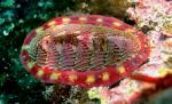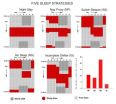(Press-News.org) (Santa Barbara, Calif.) –– Using eyes made of a calcium carbonate crystal, a simple mollusk may have evolved enough vision to spot potential predators, scientists say.
Daniel Speiser, a postdoctoral fellow in the Department of Ecology Evolution and Marine Biology at UC Santa Barbara, studied mollusks that he collected in the Florida Keys. His research of their vision, performed during his graduate studies at Duke University, resulted in a study published today by Current Biology.
The three-inch-long mollusks, called chitons, have hundreds of eye-like structures with lenses made of aragonite, a type of rock. It's the first time scientists have found an animal that makes eye lenses from aragonite and not the rock's close cousin, calcite.
Scientists discovered the chiton's unique eyes decades ago. But it wasn't clear whether chitons used these eyes to see objects overhead, or simply to sense changes in light. "Turns out they can see objects, though probably not well," said Speiser.
"It's surprising how these creatures make their eyes from rocks," said Sönke Johnsen, associate professor of biology at Duke. Most animals make their eyes from cells with proteins and chitin. "But it seems like an easy way to evolve eyes, by using what you've already got," he said. Chitons also make their shells from aragonite.
Johnsen and Speiser studied West Indian fuzzy chitons, or Acanthopleura granulata, which have flat shells made of eight separate plates. Hundreds of tiny lenses on the surface of the plates cover clusters of light-sensitive cells beneath.
To test the creature's vision, Speiser placed individual chitons on a slate slab. When left undisturbed, they lift part of their armored, oval-shaped body to breathe. At this point, Speiser showed them either a black disk ranging from .35 centimeters to 10 centimeters in diameter or a corresponding gray slide that blocked the same amount of light. The disk or slide appeared 20 centimeters above the chitons.
When shown the gray screens, the chitons did not respond. But they clamped down when shown a black disk three centimeters or larger in diameter. That would be the equivalent of humans looking in the sky and seeing a disk the diameter of 20 moons, making human vision about a thousand times sharper than chiton vision, Johnsen said.
Because the chitons responded to the larger disks and not the gray slides, they seem to be seeing the disk and not simply responding to a change in light, said University of Sussex biologist Michael Land, an expert on animal vision who was not involved in the research. It's not yet clear if they respond only to the removal of light by the disk as opposed to added light.
Land also said it's not likely that the chitons' eyes were part of the evolutionary route to human eyes.
Chitons are an ancient, primitive species that first appeared on Earth more than 500 million years ago. But the oldest chitons with eyes only began to appear in the fossil record in the last 25 million years, making their eyes among the most recent to evolve in animals. Speiser said chitons probably evolved to have eyes with lenses so they could see their predators and defend themselves against being eaten.
Speiser and his colleagues also tested whether the chitons' eyes work in both air and water, since some species spend time in both. The experiments made a strong case for the chiton lens being able to focus light differently, depending on whether the animal is above or below water, Land said.
He added that chiton eyes are still an anomaly in the evolution of vision. The retinas are structurally similar to snail and slug retinas. But snail and slug retinas respond to the appearance of light, while chiton retinas may only respond to the removal of light, a difference that might be worth another look, Land said.
INFORMATION:
Eyes of rock let chitons see predators
2011-04-15
ELSE PRESS RELEASES FROM THIS DATE:
Business Education Simulations from Realityworks, Inc. Highlighted in Scholastic Administrator Magazine "Best in Technology" Article
2011-04-15
Experiential learning technology that allows students to simulate a real business office environment was recently featured in the Scholastic Administrator Spring 2011 magazine. The article, entitled "Best in Tech: Piloting New Technology", showcased a review by Ruthie Bass of North Shore Senior High School, Galena Park ISD in Houston, Texas of Business Education Simulations program from Realityworks, Inc.
The Scholastic Administrator article highlights district leaders piloting programs with new technologies and how they are incorporating them into the classroom. The ...
Rising star of brain found to regulate circadian rhythms
2011-04-15
BOSTON (April 14, 2011, noon ET) — The circadian system that controls normal sleep patterns is regulated by a group of glial brain cells called astrocytes, according to a study published online on April 14th in Current Biology, a Cell Press publication. Neuroscientists from Tufts University School of Medicine found that disruption of astrocyte function in fruit flies (Drosophila) led to altered daily rhythms, an indication that these star-shaped glial cells contribute to the control of circadian behavior. These results provide, for the first time, a tractable genetic model ...
Carbon sequestration estimate in US increased -- barring a drought
2011-04-15
CORVALLIS, Ore. – A research group has concluded that forests and other terrestrial ecosystems in the lower 48 states can sequester up to 40 percent of the nation's fossil fuel carbon emissions, a larger amount than previously estimated – unless a drought or other major disturbance occurs.
Widespread droughts, such as those that occurred in 2002 and 2006, can cut the amount of carbon sequestered by about 20 percent, the scientists concluded in a recent study that was supported by the National Science Foundation and U.S. Department of Energy.
The research, published ...
Study: Compassion, not sanctions, is best response to workplace anger
2011-04-15
Challenging traditional views of workplace anger, a new article by a Temple University Fox School of Business professor suggests that even intense emotional outbursts can prove beneficial if responded to with compassion.
Dr. Deanna Geddes, chair of the Fox School's Human Resource Management Department, argues that more supportive responses by managers and co-workers after displays of deviant anger can promote positive change at work, while sanctioning or doing nothing does not.
"The trouble with sanctions: Organizational responses to deviant anger displays at work," ...
Toward a more efficient use of solar energy
2011-04-15
This release is available in German.
The exploitation and utilization of new energy sources are considered to be among today's major challenges. Solar energy plays a central role, and its direct conversion into chemical energy, for example hydrogen generation by water splitting, is one of its interesting variants. Titanium oxide-based photocatalysis is the presently most efficient, yet little understood conversion process. In cooperation with colleagues from Germany and abroad, scientists of the KIT Institute for Functional Interfaces (IFG) have studied the basic mechanisms ...
Wikipedia deemed a reliable source for political info by new study
2011-04-15
Not so long ago Wikipedia was considered a playground for Capitol Hill staffers to game the system and make "the boss look better and the opponent look ridiculous."
Now a peer-reviewed study by Brigham Young University political scientist Adam Brown validates Wikipedia as a reliable place to get a political education.
The research focused on past and present candidates for governor across the 50 states. Brown fact-checked biographical information and voting statistics and found very few inaccuracies.
"My finding is optimistic for the health of our country," said ...
A sleep strategy commonly used by night nurses throws off their circadian clocks
2011-04-15
As many as 25 percent of hospital nurses go without sleep for at least 24 hours in order to adjust to working on the night shift, which is the least effective strategy for adapting their internal, circadian clocks to a night-time schedule.
That is one of the results of the first study to examine the strategies that night nurses use to adjust between day and night sleep cycles. The study was based on questionnaires from 388 nurses who work at the Vanderbilt University Medical Center and the results are published in the April 13 issue of the scientific journal, Public ...
New ACE survey shows people with type 2 diabetes experience low blood sugar during typical daily activities
2011-04-15
SAN DIEGO, Calif., April 14, 2011 – New survey data released today at the American Association of Clinical Endocrinologists (AACE) 20th Annual Meeting and Clinical Congress reveal that more than half (55%) of people with type 2 diabetes across the country report they have experienced hypoglycemia, or low blood sugar. What's more, many experienced it during typical daily activities such as working (42%), exercising (26%) and driving (19%), according to the survey, designed by the American College of Endocrinology (ACE) and supported by Merck. Recognizing symptoms like nervousness, ...
Temporary memory loss strikes hospitalized seniors
2011-04-15
CHICAGO --- Battling an illness, lack of sleep and strange surroundings can make any hospital patient feel out of sorts.
For seniors, hospitalizations actually may cause temporary memory loss and difficulty in understanding discharge instructions, according to a new Northwestern Medicine study.
The seniors go back to normal one month after the hospital stay, the study found. But immediately following a hospitalization is a critical time in which seniors may need extra support from healthcare professionals and family, according to Lee Lindquist, the lead author of ...
Recent census in war-torn DR Congo finds gorillas have survived, even increased
2011-04-15
A census team led by the Wildlife Conservation Society and the Insitut Congolais pour la Conservation de la Nature (ICCN) in Kahuzi-Biega National Park in the Democratic Republic of Congo today announced some encouraging news from a region plagued by warfare and insecurity: a small population of Grauer's gorillas has not only survived, but also increased since the last census.
The census, conducted late 2010 in the highland sector of Kahuzi-Biega National Park, revealed the presence of 181 individual Grauer's gorillas, up from 168 individuals detected in the same sector ...


